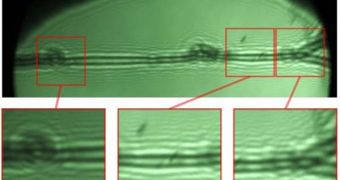Groundbreaking imaging techniques today reveal details of the small-scale world that were never before thought possible. They can image single atoms and structures just nanometers across, but they are notorious for not being able to look inside living molecules. The highly energetic streams of particles they use for their analysis damages living cells, proteins or the DNA to a great extent, making live observations of the processes going on inside cells extremely difficult. Now, a new technique overcomes these hurdles and opens the way for a new class of scientific studies, Technology Review reports.
A previous approach to imagine DNA and RNA molecules was to make them into a crystal and then bombard the structure with high-energy electrons, or X-rays. This method ensured that the scientists doing the investigation could see the shape of the molecule inside the crystal, by analyzing the diffraction patterns that were generated when the beams bounced off the crystal. The problem with this method is that molecules take different shapes, and the diffraction patterns only hinted at the overall form of the clump, in which several molecules were located.
In a completely different approach, experts at the University of Zurich, led by scientist Matthias Germann, used a coherent beam of low-energy electrons to create “holograms” of DNA strands. Some wonder why this method was not tried out in the past, or why it didn't work when it was. The team reveals that, at certain low energies, the DNA strands are extremely resistant to the actions of electrons in a beam.
“DNA withstands irradiation by coherent low energy electrons and remains unperturbed even after a total dose of at least 5 orders of magnitude larger than the permissible dose in X-ray or high energy electron imaging,” the investigators say.
Essentially, the team has found a way of imaging DNA strands without inflicting damage onto them, which is something that was never accomplished before. They report that applying an energy of about 60eV to the electron beams is sufficient to capture wonderful images of the molecules, which still maintain their internal structure intact.
The immediate implication of the new achievement is that the study of proteins and other biomolecules could become a lot easier in the near future than it is today. Additionally, DNA sequencing could simply become a matter of “towing” a DNA sample in front of the right kind of camera.

 14 DAY TRIAL //
14 DAY TRIAL //